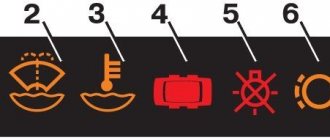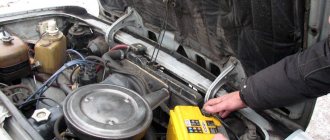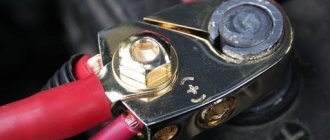How to find out why the battery charge indicator is on
And the first thing worth checking is the tension of the generator belt . The minimum speed at which charging begins is 1500 rpm, and if the belt is loose, it will slip, as a result of which the light with the image of the battery will blink or light up at low speeds. But if everything is in order there, then the reason clearly lies somewhere inside the generator or the wiring itself. The easiest way to determine if the generator is faulty is to look at the intensity of the lighting of all the other lamps that are lit on the instrument panel, in addition to the battery light. And to find out if there is a problem with the power supply of the car battery, you need to:
- The old-fashioned way of checking is to remove one terminal from the battery while the engine is running, and if the car, despite this, continues to work normally, then everything is in order with the generator and it does not need repairs. This method is strictly prohibited on injection engines.
- The second thing you need is to measure the voltage at the battery terminals with the engine running - it should be about 14.2 - 14.7 V. If the charge is lower, then the cause is clearly a faulty generator. But first, you should clean all the terminals with sandpaper.
The battery light comes on after the engine starts.
The main part of the battery energy is spent on turning on the ignition system and starting the engine. Starting the engine is accompanied by a significant consumption of the battery's electrical charge, and to ensure repeated starting of the engine, the vehicle's electrical network is equipped with a recharging system. After starting the engine, the generator generates electricity, part of which is supplied to the battery to restore charge.
Recharging the battery requires constant monitoring by the driver. If the system is operational, then when the ignition is turned on, the battery charging warning lamp lights up for a few seconds at idle, which signals that the generator-battery circuit is in good condition. After the engine starts, the battery indicator light should go out, indicating that the battery is charging.
If the battery warning light continues to light or lights up again on the instrument panel, then action must be taken. Otherwise, the car may stall on the way, or after stopping the engine again, it will not be possible to start it again.
The battery light may light differently. In one case, it does not go out after starting the engine or lights up brightly while driving. In the other, it burns only under certain engine operating conditions. For example, it glows dimly at medium speeds, but as the speed decreases, the intensity of the glow increases.
Causes of malfunction in the generator
The battery icon light may be constantly on when the brushes, diode bridge, contact rings of the commutator are worn out, also when the generator regulator relay burns out or there is a break in the armature field winding (a break is most unlikely).
Graphite brushes contribute to the generation of electricity, and like all auto parts, they are subject to wear due to friction against the slip rings on the shaft.
The regulator relay (chocolate bar) supplies a current of a certain voltage and when it burns out, the charging current stops flowing or the battery is overcharged.
What to do if the battery light is on or the light is off but there is no charging: diagnostics
In a situation where the battery light is on while the engine is running, you need to check the voltage at the battery terminals with a multimeter. This can be done quickly, and the voltage itself should normally be 13.5-14.3V. When there is no charging, the voltage will be about 12V.
To check the charging status in more detail, you need to prepare a pair of screwdrivers (flat and Phillips), a 12V test lamp, a multimeter, a knife and pliers, as well as fine sandpaper. Now let's look at the main problems when the battery light comes on.
- First, the generator is charging, the tester at the battery terminals shows a voltage of 12V, and the battery itself is discharged. In such a situation, stripping of the terminals and wires will be required. After cleaning, the voltage on the battery is measured again.
- Secondly, the battery is discharged, and the voltage on the battery is 14V, but it drops under load. In this case, the cause may be poor tension of the generator belt, problems with the pulley, failure or wear of the generator bearings.
You also need to check the diode bridge and stator winding, since a breakdown of one diode can lead to insufficient charging. To believe this, you need to turn off the ignition, then check the generator, its diodes and other elements with a multimeter. At the same time, the generator brushes are also checked (if their length is less than 5 mm, the generator brushes need to be replaced).
Another situation where the battery is not charging may be due to a blown fuse. Usually this is an F10 fuse with a rating of 10 A. In some cases, replacing it can solve the problem. There may also be a problem with the ignition switch or relay. To determine, a ring with a multimeter is required.
- Note that it also happens that after turning the key there is no charge in the lock, but the devices work. To check, you need to remove the wire from the generator terminal, and then connect it to negative or to the body. If the control lamp lights up, then the generator excitation winding has failed.
Often the culprit may be a bad contact in the connector to the battery lamp itself. To eliminate this problem, you need to clean all contacts and connectors. If the problem is with the light bulb (it does not burn brightly, intermittently or does not light), then attention should be paid to other icons. If the lights are dim, then the problem is not with the lamp. If the other indicators glow brightly, then the battery light itself or its contacts may be faulty.
If all of the above checks did not produce results, then you need to move on to how to check the relay regulator. To do this, voltage is applied to the contacts. The voltage on the brushes is also checked. When the voltage is 12V, the relay works normally. If not, then it will need to be replaced.
How to find out the reason for the lack of charge on the road
Naturally, such checks cannot be done on the road, so you should focus your attention not on the generator itself, but on its wiring. You need to check the contacts, perhaps they have oxidized or become loose. It is also worth checking the insulation of the wire going from the generator to the battery; perhaps it was damaged due to some repair work under the hood, and the copper wires inside were covered with salt, which is why they rotted or lost contact.
If you cannot find the cause of the malfunction on your own, and there is no visible reason why the battery light came on, then you should still go to the nearest auto electrician.
Add a comment Cancel reply
You must be logged in to post a comment.
We have already complained more than once that today it is becoming more and more difficult for drivers to diagnose their own cars, especially while driving. The toolkit is constantly shrinking. Let's say that voltmeters have disappeared from dashboards like mammoths, and the driver learns about all problems with charging after the fact from a message from a laconic warning light. But even with the lamp, not everything is so rosy, they don’t talk about it in driving schools, in the instructions for the car there is only the phrase “contact the service center.” Most drivers roughly imagine that it is responsible for charging, but how exactly and what exactly it shows is something that not everyone understands.
Let's sum it up
As you can see, there are many reasons why problems arise with battery charging. In this case, the battery icon on the panel may often light up constantly, blink, or, conversely, not light up. To detect the cause, it is necessary to check individual elements step by step as discussed above.
If the battery is normal, there are no other hidden reasons for its discharge, then often the culprit is the generator, relay - regulator or bad contact. Moreover, after conducting qualified diagnostics, it is possible to identify, localize and efficiently eliminate the malfunction.
Why does the “check engine” light on the instrument panel light up: the main reasons. What should a driver do if the check light is on in the car? Useful tips and tricks.
Icons on the dashboard: symbols and explanation of car instrument panel icons. Types of icons and indicators, what do the lights on the panel mean.
Why the oil pressure light comes on after the engine warms up: the main reasons. What should a driver do if the oil pressure comes on when the engine is warm.
Why does the check light light up on the dashboard? Is it possible to continue driving a car if the check engine light is on? What should you check first?
An exclamation mark on the dashboard lights up: what does an exclamation mark on a yellow background mean, an exclamation mark on a red background, diagnostics.
Why the starter may not work after turning the key in the ignition. The main causes of starter malfunctions: bendix, traction relay, brushes, winding.
How does a generator work?
Before you understand why the battery charging light comes on, you need to understand the principle of operation of the generator. Any car has two power sources. This is a generator and battery. They are connected in parallel. Therefore, when the engine is running, the generator supplies voltage to the battery and charges it. Moreover, there is one peculiarity. Regardless of the speed, the voltage at the generator output is always the same.
To stabilize it, a relay regulator is installed. Older cars used electromechanical-type designs. Modern ones use exclusively semiconductor ones. The lamp, which is installed in the dashboard, is included in the power circuit of the voltage regulator. It essentially serves as a fuse. To understand the essence, it is necessary to thoroughly study the principle of operation of the voltage regulator relay.
Connection diagrams for generators of different models
VAZ 2106 cars are equipped with G-221A generators from the factory. Nowadays, motorists often equip their vehicles with powerful audio systems, navigators and other devices. The G-221A cannot always cope with the increased load. Therefore, now car owners are installing more powerful devices instead. You can install generators such as G-222 or 37.3701 on a VAZ 2106 car.
Connection diagram G-221A
The G-221A generator is installed on VAZ 2101-2104, VAZ-2106, 2107 cars. Its rectified current is 42 A, and its maximum power is 588 W. The connection diagram is shown in the figure below.
Connection diagram G-221A
Here the numbers indicate:
- Battery.
- Generator.
- Fuse box.
- Ignition switch.
- Dashboard.
The operating principle of this scheme is as follows. When the ignition is turned on, before the car engine spins up the generator, current from the positive terminal of the battery through the ignition switch and the fuse box goes to the warning light. From it, through a diode, it goes to the ground, to which the negative terminal of the VAZ 2107 battery is also connected. Thus, the circuit is closed, the control lamp is on.
When the generator spins up, a positive voltage of +14 V comes from its output to connector 12 of the VAZ 2107 instrument panel, which turns off the diode. The current from the battery stops flowing and the light goes out.
In the video you can see the operating principle of the G-221A generator circuit.
Connection G-222
G-222 is capable of delivering a current of 50 A. Its connection diagram can be found in the figure below.
Connection diagram G-222
Its operating principle is as follows. When the key is turned in the ignition switch, voltage from the positive terminal of the battery flows through connector 87 of the ignition relay. After this, through fuse 10 located in the fuse block, it is supplied to terminals 86 and 87 of the indicator relay. The relay closes its contacts, voltage is supplied to the lamp through contacts 7 and 3 of the mounting block, and it lights up.
As the engine spins up and the output voltage increases, the relay contacts open. As a result, the instrument panel indicator lamp goes out.
Connection 37.3701 (G-2108)
Generator 37.3701 was installed on VAZ 2108 cars, but it can be installed on VAZ 2106 and 2107. In terms of dimensions and fasteners, it is similar to the classic G-221. The output current can reach 55 A.
Connection diagram 37.3701
In this circuit, when the ignition is turned on, the +12 V voltage from the battery goes through the closed contacts of the ignition relay, the fuse, which is located in the mounting block and is indicated by number 10 in the diagram. After this, the current through the charging indicator lamp comes through connector 61 of the generator to the excitation winding.
When the rotation speed increases, the voltage on the field winding increases along with it. When the output voltage becomes 12 V, the voltage on both legs of the lamp is equalized and the lamp goes out.
Voltage regulator
Generators have two windings – rotor and stator. Moreover, the first one performs the functions of the excitation winding. We need to remember the theory: without a moving magnetic field, generating electricity is impossible. Therefore, it is enough to apply voltage to the rotor winding to obtain a magnetic field. Well, since the rotor is a moving part of an electric machine, it becomes clear that the magnetic field will rotate. And if the battery charging light periodically lights up, this indicates that there is a minor defect in the generator.
But why install a voltage regulator specifically in the power circuit of the excitation winding? After all, it is necessary to carry out stabilization in the stator circuit. This is true, but it’s worth remembering the theory: the output voltage depends on the magnitude of the magnetic field. Everything is very simple. It is enough to stabilize the power supply in the rotor winding circuit so that there are no oscillations at the output. It is much easier to stabilize small currents than large ones (can reach several tens of amperes).
Troubleshooting
Let's say that after starting the engine you notice that the battery charging light comes on. VAZ is susceptible to this problem, and it is relevant for any model. The following components need to be checked:
- Voltage regulator described above. On some vehicles it may be installed under the hood rather than inside the alternator.
- Diode bridge. One or more semiconductors may fail.
- Generator drive belt. It may be poorly tensioned, or it may have broken or slipped. If you hear a whistle, then you can judge that the bearing in the front cover is broken.
List of possible faults
Once we have found out that the voltage difference lights up the indicator, it will not be difficult to make a list of possible reasons for the absence of this difference:
- lack of charging or the amount of charge is less than the potential difference at the battery terminals;
- faulty battery lamp monitoring relay;
- poor contacts of individual circuit elements (ground connection, battery terminals, battery terminals, terminals in the mounting block).
Generator
The reason why the battery light is on may be due to the following generator failures:
- The tension is too weak or the belt drive is broken. The sensor is guaranteed to notify you about this;
- wear of the brush assembly, collector slip rings. In the nascent stage, the light on the dashboard will light up only when a large number of energy consumers are turned on. To determine such a defect, the generator will have to be disassembled, otherwise it is impossible to assess the condition of the brushes;
- malfunction of the voltage regulator, which maintains the charging amount in a range safe for the on-board network. If the regulator fails to maintain the minimum voltage, the battery sensor lights up. In case of excessively high current, rapid failure of the battery may occur, sometimes even boiling. To test it yourself, you will need a power source with the ability to change the voltage. For example, a laboratory power supply;
- break of the excitation winding. To determine, you need to “ring” the winding;
- Incorrect operation of the diode bridge. In this case, the battery icon may flash. The test is carried out with a multimeter in resistance measurement mode. If the diodes are broken, the bridge must be replaced.
Diagnostics
If the battery light on the panel is on, the first thing to do is check the charge level. To do this, use a multimeter in DC measurement mode - DCV (rules for using a multimeter). The engine should be running at idle speed, turn on the maximum possible number of consumers. Voltage readings should not be lower than 13.4 W. Otherwise, the corresponding icon will light up. Without those turned on, the normal consumption value is considered to be 14-14.2 W.
Tools for repairs
If the battery charging light comes on at rpm, most likely the belt is slipping due to low tension. But if everything is fine with this, you need to arm yourself with the following tools:
- Multimeter (preferably a dial voltmeter with a wide scale).
- A control light of 12 volts and 2-3 W power.
- Flat and Phillips screwdrivers.
- Pliers, sandpaper, knife.
With these tools on hand, you can begin repairs if the battery charging light comes on or there is another breakdown in the generator.
How to determine the cause
Self-diagnosis of a malfunction requires basic knowledge in auto electrics, and the failed unit is searched for by the elimination method.
We will need the following set of tools:
- multimeter;
- indicator light (car 12 V);
- a pair of flat-head and Phillips-head screwdrivers;
- pliers;
- fine-grained sandpaper.
We begin diagnostics by testing the battery. It is necessary to evaluate the condition of the terminals, cover and housing for dirt, oxidation or mechanical damage, and check the voltage at the terminal terminals using a multimeter.
If the battery is charged, the meter should show 12.7 V or more.
Dirty or oxidized terminals are cleaned with sandpaper; after wiping dry, it is recommended to treat the terminals with an anti-corrosion agent.
If the voltage is less than 12 V, most likely the battery no longer holds a charge and its further use does not make sense.
After the battery, we move on to inspecting the wiring. If there is no visible damage, it is worth checking the integrity of the wires using the device.
After this, you can begin checking the functionality of the generator, which is performed at idle engine speed. First, we check the voltage at the generator terminals with the consumers turned off; it should be in the range of 14.0–14.7 V. If this is the case, turn on the air conditioner and low beam headlights, that is, a serious load. The readings on the device should drop, but if the multimeter shows less than 13.5 V, then we can conclude that there is something wrong with the generator.
Checking the condition of the drive belt is carried out with the engine turned off. If there is no visible damage (cracks, delaminations), it is necessary to check the belt tension by simply pressing on it. A deflection of more than 15 mm is considered a significant deviation from the norm, and if there are mechanical defects, the belt must be unconditionally replaced.
The functionality of the voltage regulator is checked at speeds of about 3600–4000, while the voltage level at the output contacts of the regulator should not exceed 14.5 V.
If you have established that the relay regulator is working, and the Lada Kalina battery icon continues to light up, we proceed to testing all sections of the electrical circuit going to or from the generator (to the battery, fuse box, ignition switch). The check is carried out by ringing using a test light.
The fuse can be checked at any stage. If the jumper is intact, you need to make sure that the fuse is in tight contact with the socket - sometimes it weakens and causes a circuit break.
It is very rare, but there is a situation when the battery lack of charge light comes on on the dashboard, but in fact it is charging. Typically, such a malfunction of the ECU occurs in severe frosts or if the battery is 80–90% discharged. To reset this error, just turn off the ignition for 30 seconds and then turn it on again.
Breakdowns and their elimination
Let's say a voltmeter is installed in a car. And it shows that there is charging. The battery charging light also comes on periodically or does not light up at all. Measuring the voltage directly at the battery terminals shows exactly 12 volts. But the capacity is lost, the starter does not rotate, and the tape recorder has difficulty working. First of all, clean all the thick wires through which the battery is charged. Measure the voltage at terminal “30” of the generator. If it is larger than what is on the battery, strip the terminal or change the wire.
If the voltmeter on the dashboard shows the presence of charging, but the lamp does not light up, and the battery is discharged, despite the normal voltage in the on-board network, carry out a couple of simple steps. Turn on the maximum number of consumers and see how the voltmeter behaves. If the voltage drops sharply, tighten the alternator belt. It begins to slip because, under load, the rotor EMF counteracts the stator one. And it takes a lot of effort. In addition, one of the pulleys may simply wear out. Then even installing a new belt will not help.
Reasons why the battery charging light is on
In fact, there are many reasons why the battery light comes on and does not go out. These include:
- Loosening of the belt tension on the generator, its wear or damage;
- fuse blown or deterioration of contact quality in the connectors of the mounting block;
- breakdown of the relay regulator, diode bridge, additional diodes;
- the appearance of a break in the generator excitation circuit;
- decreased quality of contact at the battery terminals or generator output;
- generator brush wear;
- lack of high-quality contact of the ground wire.
What to do if the battery charging light is on?
First of all, get out of the car and, with the engine running, measure the voltage at the battery terminals (do not remove the clamps under any circumstances).
If charging is in progress, the voltage should be at 13.6-14.2 Volts. In the absence of charge, the voltage level will be much lower - about 12 Volts.
To fix the problem, prepare the following tools:
- twelve volt indicator light,
- two screwdrivers (flat and Phillips),
- multimeter,
- pliers,
- knife,
- Use sandpaper to clean contacts.
So let's get started:
1. The readings of the on-board voltmeter indicate the presence of a charge, the charge signal lamp on the dashboard does not light up, there are about 12 Volts at the battery terminals, and the battery itself is almost discharged.
In such a situation, clean the wire connections on the power source itself. If these measures are useless, measure the voltage level at terminal “30” of the generator itself.
Place one multimeter probe on this terminal, and the other on ground. If the voltage here is much higher than at the battery, then strip the thirtieth terminal. If necessary, replace the wire from the generator to the battery.
2. The voltmeter on the dashboard and the lamp show the presence of a charge, but the battery is discharged.
The voltage on the battery is normal (about 14 Volts). Turning on a load (for example, headlights) causes the charge arrow to shift to the extreme left position.
The main reason is weak belt tension on the generator pulley (tighten the belt, and if it is damaged, replace it).
New Lada: Lada Kalina 2 Sport or VAZ 2192 (2014 - 2018) |
This problem can also be caused by a breakdown of one of the diodes, as well as a break in the stator phase winding. Turn off the ignition and check the diodes with a multimeter. In case of breakdown, replace them.
Check the generator brushes. To do this, take them out and measure the length. If it is less than five millimeters, then it is better to replace the brushes.
3. When you turn the key in the ignition, the charge warning lamp does not light up, the charge sensor does not work, and there is no charge on the battery. The reason is a blown fuse.
Its designation is F10, rating is 10 Amperes. If installing a new fuse does not produce results, then the reason must be sought in the ignition relay or the lock itself.
4. After turning on the ignition, there is no charge, all devices work, the control warning lamp does not light up.
The check is simple - remove the wiring from terminal “sixty-one” of the generator and connect it directly to the “minus” (car body). If the light comes on, then the cause of the problem is the generator field winding.
The second option is bad contact in the connector. If after cleaning there is no result, then there is a risk of the lamp itself burning out.
5. When you turn the key in the ignition switch, the charge lamp lights up, and after starting it continues to light up. In this case, there is no charging or appears periodically. The reason is insufficient contact of the wire at the connector with the dashboard (it may oxidize).
Finally, check the relay regulator. To do this, apply voltage from the battery to its contacts. If there is 12 volts on the brushes, then the relay is working properly. If not, the device must be replaced.
If you have problems charging the battery (the warning light does not go out or does not light up at all), then check all versions.
But, as a rule, the problem is always on the surface, and the cause is poor contact, a burnt out light bulb or a faulty relay regulator. Good luck on the roads and of course no breakdowns.
Internal breakdowns
The above situation can occur when a semiconductor diode fails. If there is a break in the stator winding, a voltage drop under load is also observed. Disassemble the generator and diagnose the semiconductors. They have one-way conductivity. Ring the stator windings to identify a short to the housing. It is worth noting that a break can be found with a multimeter, but a bad contact is unlikely. For this purpose it is better to use a megohmmeter.
It is worth inspecting the generator brushes as well. If the battery charging light comes on at low speeds when the light is on, this also indicates the presence of the breakdowns described above. A lot depends on the brushes too. If they are 5mm or less in length, you can safely throw them away. And if the battery charging light comes on due to brush failure, the fault is very easy to find.
The battery light comes on: why does the battery light on the panel light up?
Let's start with the fact that every driver, when starting the engine, paid attention to the red battery icon that appears when the key is turned in the ignition. In this case, the battery indicator lights up until the engine starts. In other words, normally the battery icon goes out after the engine starts.
In other words, the circuit is such that after turning on the ignition, voltage is supplied through the fuse to the battery warning lamp (battery charge lamp) on the instrument panel.
The voltage then passes through the diodes, relay regulator, brushes, slip ring and winding. After starting the engine, the voltage at the terminals of the battery light is equalized, and the light goes out. At the same time, the battery is being charged. If the battery on the panel lights up constantly or such an icon lights up periodically, then this indicates a malfunction.
So, to understand why the battery light is on, you need to look at the reasons why the battery light may come on. Let us immediately note that this indicator monitors the connection between the battery and the generator. Let's figure it out.
The battery charging light is on: possible causes of the malfunction
As you know, a car battery is closely connected to the generator. To start the engine, electricity from the battery is supplied to the starter, but after the internal combustion engine starts working, the current is generated by a generator that spins from the running engine.
In this case, the battery is in recharging mode from the generator. Moreover, if the engine speed increases, then the voltage produced by the generator also increases. To prevent overcharging the battery or supplying too high voltage, there is a relay regulator on the generator.
The main task of the device is to ensure that the current from the generator to the battery is always optimal, that is, the voltage does not depend on engine speed. This makes it possible to constantly obtain and maintain the required voltage.
As a rule, the list of frequent breakdowns includes:
- problems with the relay regulator;
- failure of the diode bridge;
- the alternator belt is broken, poorly tensioned or slipping;
- severe play in generator bearings and wedging;
- blown fuses;
- poor contacts at the battery terminals, at the generator output, on the ground wire;
- generator circuit open;
- wear of generator brushes or brush holders;
- there may be problems with the ignition switch;
A few more common breakdowns
But most often it happens that the battery charging light does not light up, but there is a breakdown. Moreover, if the lamp itself burns out, the voltage on the excitation winding disappears. It is easy to identify a malfunction - you need to check the filament of the lighting fixture itself. But most often the lamp blinks and may light up briefly. Often the cause of this behavior is a broken contact in the power supply circuit of the field winding. To resolve, clean all connectors using a knife, sandpaper, or use a penetrating lubricant such as WD-40.











